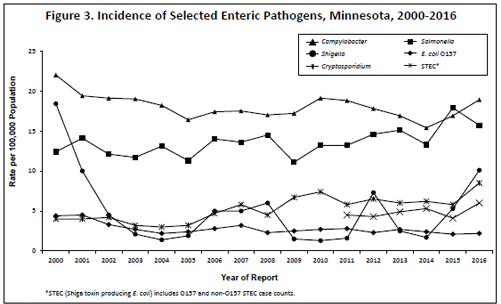Annual Summary of Disease Activity:
Disease Control Newsletter (DCN)
Related Topics
Contact Info
Escherichia coli O157 Infection and Hemolytic Uremic Syndrome (HUS), 2016
During 2016, 122 culture-confirmed cases of Escherichia coli O157 infection (2.21 per 100,000 population) were reported. The number of cases represents a 10% decrease from the median number reported annually from 2006 to 2015 (median, 136 cases; range, 114 to 163). During 2016, 44 (36%) cases occurred in the metropolitan area. Eighty-six (70%) occurred during May through October. The median age of the cases was 18 years (range, 5 months to 87 years). Twenty-seven percent were 4 years of age or younger. Forty-one (33%) were hospitalized; the median hospital stay was 3 days (range, 1 to 42 days). No cases died.
In addition to the 122 culture-confirmed E. coli O157 cases, 204 cases of Shiga toxin-producing E. coli (STEC) infection were identified in 2016. Of those, culture-confirmation was not possible in 8, and therefore it is unknown if those were O157 or another serogroup. Among the remaining 196 cases with STEC other than O157, E. coli O103 accounted for 47 (24%) cases, E. coli O111 for 28 (14%), E. coli O26 for 27 (14%), E. coli O145 for 19 (10%), E. coli O121 for 18 (9%), and E. coli O45 for 5 (3%). The median age of the non-O157 STEC cases was 25 years (range, 4 months to 94 years). Forty (20%) cases were hospitalized; the median hospital stay was 2 days (range, 1 to 10 days). One case, an 87 year-old, died.
Culture-independent tests (CIDTs) have become increasingly adopted by clinical laboratories for the detection of Shiga toxin in stool. Eighty-four patient specimens that were positive by a CIDT conducted at a clinical laboratory were not subsequently culture-confirmed, and therefore did not meet the surveillance case definition for inclusion in MDH case count totals.
Six E. coli O157 outbreaks were identified during 2016. Four outbreaks were due to person-to-person transmission in childcare facilities, one outbreak involved foodborne transmission, and a transmission route could not be identified in one outbreak. The six outbreaks resulted in 38 illnesses. In January, an outbreak was associated with commercially distributed alfalfa sprouts. Seven cases, all laboratoryconfirmed, were identified. The implicated product was recalled. A second outbreak with person-toperson transmission occurred at a childcare facility in Kanabec County. Four cases, one laboratory-confirmed, were identified. A third outbreak was associated with a festival at a middle school. The transmission route was not determined. Three cases, all laboratory-confirmed, were identified. A fourth outbreak with person-toperson transmission occurred at a childcare facility in Stearns County. Eight cases, all laboratory-confirmed, were identified. A fifth outbreak with person-to-person transmission occurred at a childcare facility in Lyon County. Ten cases, all laboratoryconfirmed, were identified. Two cases developed hemolytic uremic syndrome. Lastly, an outbreak with person-to-person transmission occurred at a childcare facility in Rice County. Two cases, both laboratoryconfirmed, were identified.
Two non-O157 STEC outbreaks were identified during 2016. One involved foodborne transmission and one was due to animal contact. An outbreak of E. coli O145 infections was associated with animal contact at an outreach center. Two cases, both laboratoryconfirmed, were identified in Minnesota. A multistate outbreak of E. coli O121 and E. coli O26 infections was associated with flour. Seven cases, all laboratory-confirmed, were identified in Minnesota. The implicated product was recalled.
Hemolytic Uremic Syndrome (HUS)
In 2016, 14 HUS cases were reported. The number of reported cases is similar to the median number of cases reported annually from 2006 to 2015 (median, 14.5 cases; range, 10 to 22). In 2016, the median age of HUS cases was 4.2 years (range, 10 months to 13 years); 10 cases occurred in children <7 years of age. All 14 cases were hospitalized, with a median hospital stay of 17 days (range, 5 to 41 days). No cases died. From 1997 through 2016, the overall case fatality rate among HUS cases was 4.9%. Thirteen HUS cases reported in 2016 were post-diarrheal. E. coli O157:H7 was cultured from the stool of 11 (82%) cases, and E. coli O145 was cultured from the stool of one case. In 2016, there were 3 outbreak-associated HUS cases.

- For up to date information see:E. coli O157:H7 and HUS
- Full issue>> Annual Summary of Communicable Diseases Reported to the Minnesota Department of Health, 2016